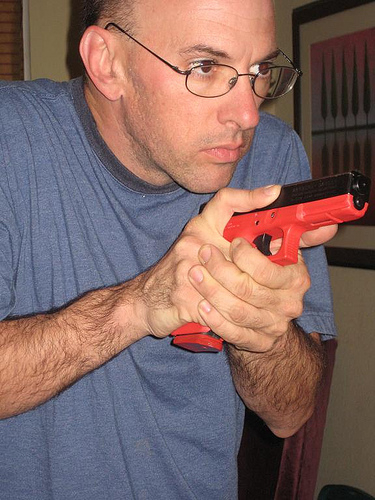A law enforcement online journal recently ran a piece from a doctor who referred to Rule Three (Keep your finger off the trigger until the sights are on the target) as “… widespread and unchallenged misguided tactical weakness and hesitantly (sic) ...” He goes on to note the “seriously compromised grip of the weapon and the resulting retention problem of trying to hold on to a weapon during an unforeseen potential struggle with only two fingers …”
So, who needs operational safety?


Apparently an 11-year police veteran in Massachusetts who was on a call out to an “armed subject at a school” call. Having perhaps cleared the structure along with other officers, he went to holster his pistol in a school restroom when the “gun fired.” The call was bogus.
A news account related as follows: ““The officer reported that as he (holstered the pistol), his index finger was extended along the side of the barrel (sic), which is consistent with his training, and that a secondary piece of equipment interfered with the holstering process, resulting in a single shot being discharged and striking the bathroom tile floor next to the officer’s foot,” the town said.”
No one was injured but the incident increased the level of response to the school.
Yes, that’s not a finger on the trigger case – there are lots of those – but a ‘failure to security sweep the mouth of the holster” case. The rules are in place for reasons. Remember Chesterton’s Fence: “There exists in such a case a certain institution or law; let us say, for the sake of simplicity, a fence or gate erected across a road. The more modern type of reformer goes gaily up to it and says, “I don’t see the use of this; let us clear it away.” To which the more intelligent type of reformer will do well to answer: “If you don’t see the use of it, I certainly won’t let you clear it away. Go away and think. Then, when you can come back and tell me that you do see the use of it, I may allow you to destroy it.” (Chesterton, The Thing, 1929)
The originating screed for this piece is generated from facts not in evidence; “widespread and unchallenged misguided,” he said. “…seriously compromised grip … retention problem,” he said.
No, no, no, no – and no.
Take a gander at the following images, one a book cover from book on fighting in close quarters by Richard Nance and the other an image found years ago on the internet for which I have no idea who to credit.


Look at the shooter’s grip on the gun as opposed to the (attempted) disarmer on the book cover. Look at high register, demonstrated by Paul Gomez (RIP) on the other.
Those grips look like “two finger” compromised grips to you?
Me either.
While I was at HK International Training Division, taking Tac Pistol Instructor and Pistol Instructor, they used recent law enforcement incidents to drive home Rule 3. One was an officer responding to a critical call for service (some felony in progress). Walking across an open area at night to get to the case address – gun in hand, he stepped in a hole.
He began to fall, caught himself as he triggered a round unintentionally. Another was a foot chase of an armed perpetrator. The officer didn’t see the clothesline, but the clothesline caught him at about throat level.
You guessed it, he launched a round also.
Look at the Paul Gomez image again. Note how his finger is bent, crooked into the ejection port. Not everyone can reach that on every gun, but you can bend your finger. A straight finger can slam closed, as pointed out by Mas Ayoob years ago. The bent index finger is already closed and pressing in on the side of the gun. It’s going nowhere.

As for gun retention, if your finger is on the trigger when the gun is grabbed, you (1) may unintentionally fire when the muzzle is averted from your attacker (therefore potentially muzzling someone else) and (2) that index finger will likely be broken as the gun is twisted out of your grasp, compounding your problems.
Want to minimize the gun-grab threat? Get thee to a class. There are Lindell certified instructors around the country (consider Agile Training and Consulting) and Rich Nance is teaching close quarters fighting with (nonfiring) guns with an eye to maintaining custody of the piece.
Our doctor notes that Rule 3 means that the user will, under stress, have to ‘remember’ where the trigger is and find it (I’ve never seen anyone miss it – ever) and that we need “… better selection in recruitment and better training in deadly force weapons ....”
Something upon which we agree. As long as he’s not providing the training.
-- Rich Grassi